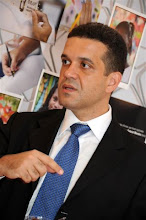- Back to Home »
- Social technology for small farms
Brazil has 1.3 million producers of milk and 80% work on manual milking. Aware of the need for these small and medium producers, Embrapa developed a manual milking kit. Defined as a social technology at the hands of small producers, the kit is composed of simple utensils associated to a book of instructions with guidance regarding maual milking. The project developed by Embrapa Dairy Cattle counted on partnership with the Ministry of Agrarian Development, Emater-MG, Embrapa Semiarid and Arthur Bernardes Foundation (Funarbe), connected to the Federal University of Viçosa.
According to Marne Moreira, joint head at the Embrapa Dairy Cattle, the work proves that it is possible to work on manual milking with the same quality and technical ability, or even better quality, than that obtained with mechanical milking. The bacterial count, one of the factors that determines the quality of the product, is usually very high in this kind of milking. This takes place due to incorrect procedures that cause deficient hygiene both on the cow's teats, on the hands of the milkers and on the equipment used.
To prove the viability of the kit, Embrapa Dairy Cattle researchers promoted tests starting in October 2006 considering seven states in almost all the Brazilian regions (Northeast, Southeast, Midwest and South). Such studies show that more adequate use may reduce the bacterial count from between 40% to 85%. Examples of this are the figures collected among a group of farmers from Pernambuco: before the use of the kit, the bacterial count (samples tested 15 minutes after milking) was around 820,000 Colony Forming Units (CFU) per millilitre of milk. With the utensils recommended and the correct hygiene procedures the CFU level dropped to 133,000/ml in the same period after milking.
The producer sets up his kit according to the material he has on his property. The complete kit costs around R$ 150 (US$ 64). The success of the initiative was so great that the idea was exported to other tropical countries like Venezuela, Colombia and Ecuador. There is also a chance of it being taken to Angola and Uganda, in Africa, and India and Pakistan, in Asia.
"The kit adds value to the milk produced as it reduces the bacterial count. It is safer for the producer, for the industry and for the consumer," stated Moreira.
Farmer Liberalino de Castro Lopes has been using the kit for a year. On his property in Juiz de Fora, Minas Gerais, he has 35 dairy cows. Daily production is 250 litres of milk and sales go to a local cheese factory.
"We always milked manually and took great care with things like washing the cow's teats with chlorinated water and rinsing them off. The kit, apart from being more hygienic, is faster and more practical. With the lower volume of bacteria I can make 20 centavos (US$ 0,11) more per litre of milk," celebrates the farmer. As he is a member of the board at the Rural Union of Juiz de Fora, Lopes is always present at the meetings, talks and field trips in the city. After that, he puts into practice what he learnt with the technicians.













